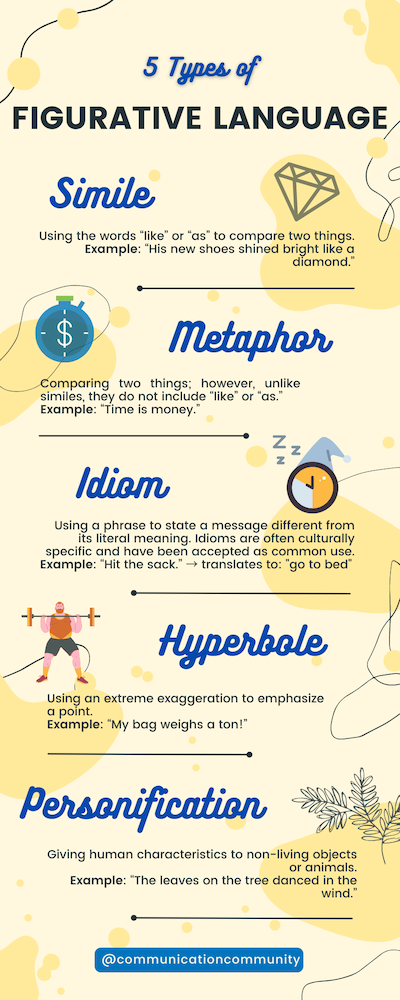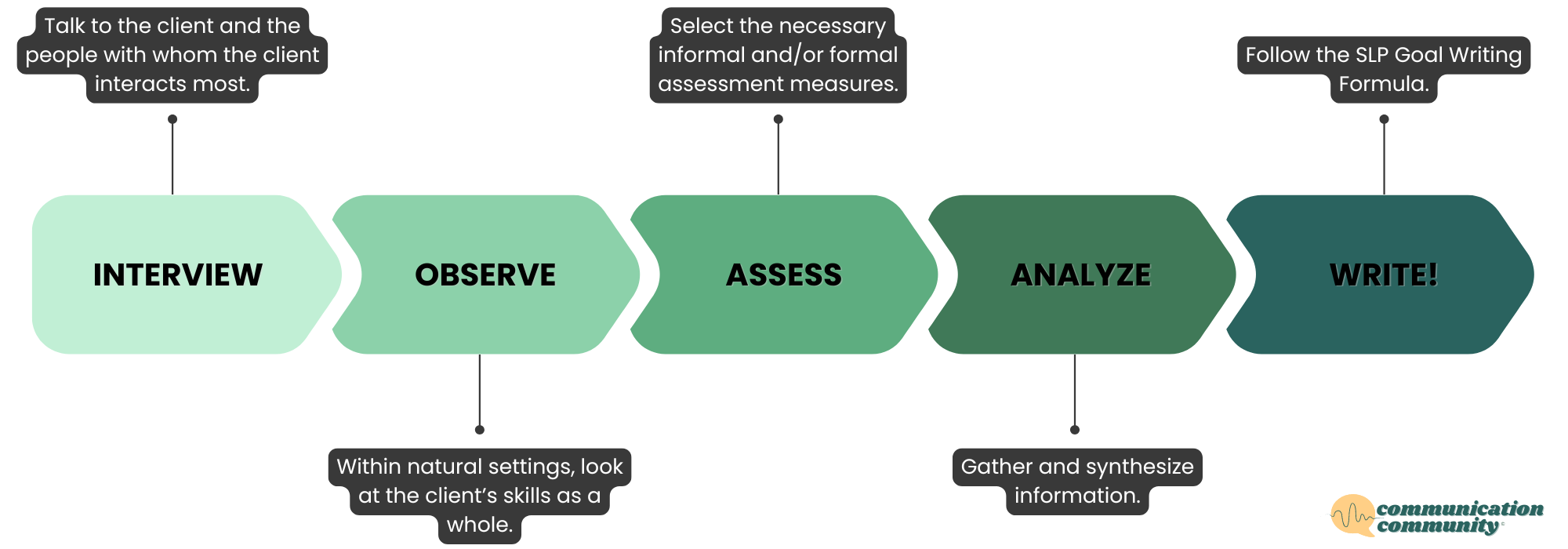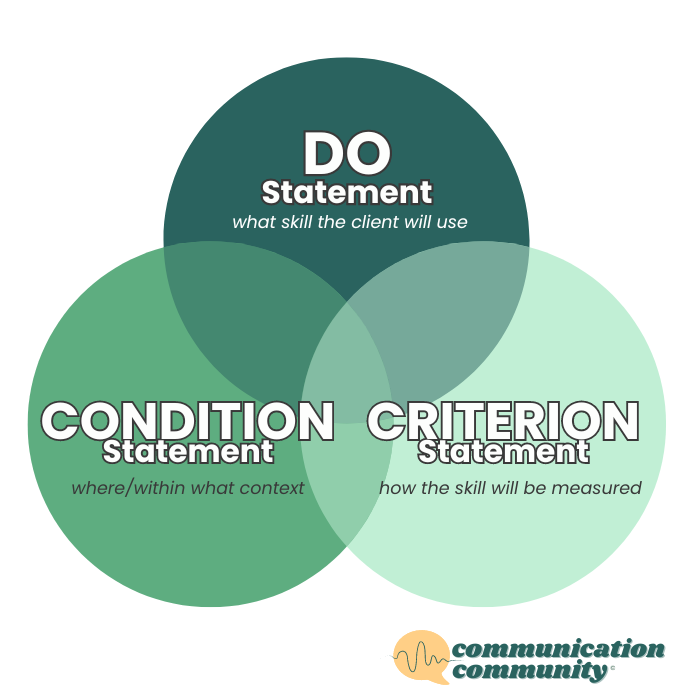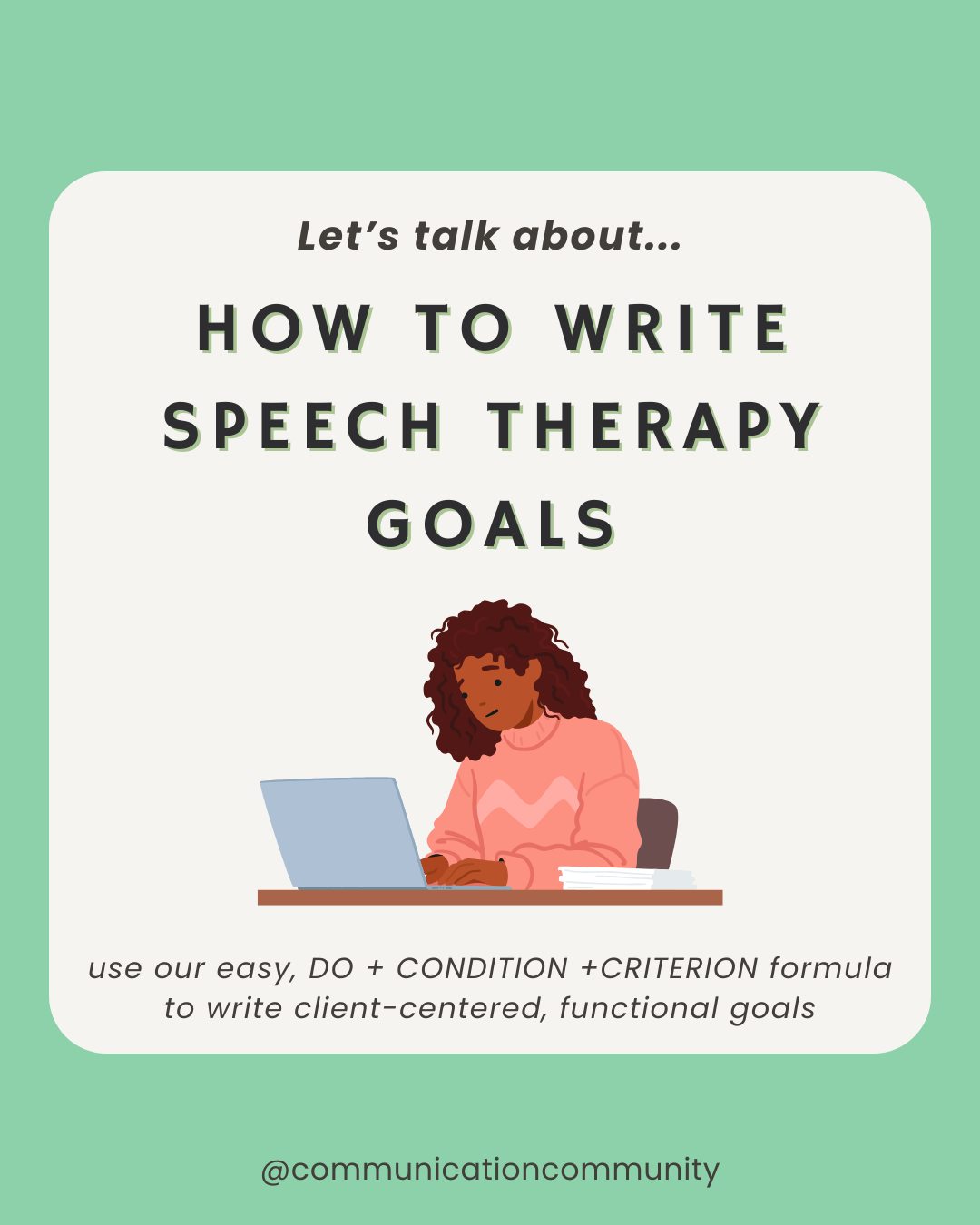Did you know...
Our comprehensive goal banks for school-aged language, AAC, Early Intervention, fluency, etc. are all available for one price in our Premium Community.

Save time creating goals with over THOUSANDS of possible goal combinations. Select your own combination of DO + CONDITION + CRITERION (and consistency) statements to develop personalized and measurable goals for your caseload.

Figurative Language: About
Figurative language is a form of expression that uses nonliteral meanings to convey a more abstract meaning or message. Oftentimes, it requires the reader/listener to make inferences from written/spoken context. There are many types of figurative language, including similes, metaphors, idioms, hyperboles, and personification*.

Literal versus figurative language
- Literal language: The message is expressed exactly how it is intended (e.g., “I have three homework assignments to finish tonight.”)
- Figurative language: The message requires inferencing/interpretation or has been learned (e.g., “It is going to take me forever to finish my homework.”
Why Do We Target Figurative Language?
Figurative language skills are a form of higher-order, abstract language. Understanding figurative language is important when it comes to higher academic levels (e.g., middle/high school and college) and the development of complex literacy skills (e.g., the ability to read advanced literature and write longer essays). Individuals with language learning disorders are more likely to experience difficulty understanding the meaning of figurative language in written and oral language, which can impact literacy skills.
Having difficulties with understanding figurative language is also common in autistic individuals, who may experience differences when interpreting pragmatic language (social language) messages and language delivered non-literally. Part of this comprehension difference is that understanding figurative language requires us as listeners to infer and reason meaning from context. For individuals who learn in a more literal manner, this can be a more complex concept to grasp without explicit instruction.
Individuals who have demonstrated difficulty understanding figurative language may benefit from goals and interventions that specifically target these skills. Below is a step-by-step process for writing figurative language goals, with a goal bank containing examples at the bottom.
Writing Figurative Language Goals
If you haven’t already, check out our article that outlines How to Write Speech Therapy Goals.
For the purpose of this article, we will focus specifically on writing goals for increasing figurative language understanding during therapy or other related instruction.


Steps for writing goals for speech and language skills (left); Communication Community goal writing formula (right)
The first step to writing goals is identifying the area(s) of need. This may include formal and informal assessments, observations, and interviews with clients, parents, teachers, and/or caregivers. Once you have identified the area(s) or need, you can begin composing the goals you are going to write and target.
As seen above, speech goals should be written with 3* components in mind: the DO statement, the CONDITION statement, and the CRITERION statement.
*Also commonly included is consistency (we incorporate this!). Aka: does the individual have to meet a specific criterion more than once? A common example of this may include across 3 consecutive sessions. This is usually something understood by the therapy organization/service provider and is sometimes/sometimes not included in the written goal itself. Including consistency statements ensure that the skill has been generalized and provides more reliable data that the skill has been properly mastered.
DO statement
What the client is actually going to DO and the specific skill they will be working towards.
Example: will use 2 novel idioms
CONDITION statement
The specific setting and/or context your client will work on this skill.
Example: within a structured or unstructured conversational task
CRITERION statement
How the client’s performance will be measured.
Example: in 80% of opportunities
DO + CONDITION + CRITERION
Example: [Client] will use 2 novel idioms, within a structured or unstructured conversational task, in 80% of opportunities.
There you have it! An example using our Goal Writing Formula containing the DO + CONDITION + CRITERION (don’t forget to think about consistency!) for increasing figurative language skills.
Figurative Language Goal Bank
Below are a series of goal examples targeting figurative language skills within the areas of receptive language, expressive language, and literacy concepts. The goals below can serve as solid examples for common figurative language skill areas, in addition to guides/templates to help you generate and customize your own goals. You can take parts of some goals and mix them with others too (e.g. take the “do” statement from one goal and the “condition” from another)!
Receptive: understanding
Example #1: [Client] will match the correct idiom with its corresponding definition, when provided in a multiple choice field, with 80% accuracy.
Example #2: [Client] will differentiate between literal versus figurative language sentences, in a worksheet format (e.g., circle literal, underline figurative), with 90% accuracy.
Example #3: [Client] will infer the correct type of figurative language form within sentences, given a word bank, in 9 out of 10 trials.
Example #4: [Client] will raise his/her/their hand when symbolic language is identified, when presented in a passage read aloud, in 80% of opportunities.
Expressive: use/expression
Example #1: [Client] will correctly use 2 different types of figurative language, within various conversational tasks, in 80% of opportunities.
Example #2: [Client] will state the correct type of figurative language, when provided with a written/oral sentence containing a simile, metaphor, or oxymoron, with 90% accuracy.
Example #3: [Client] will produce the definitions of 5 different types of figurative language forms and provide an example for each, within a structured treatment task, with 80% accuracy.
Example #4: [Client] will explain the meaning of a given idiom for 8 different idioms, within an oral and/or written format, in 7 out of 8 trials.
Literacy: reading and writing
Example #1: [Client] will color mark (i.e., mark text using colored pencils/highlighters) to illustrate 4 types of figurative language, within a grade-level reading passage, with 75% accuracy.
Example #2: [Client] will identify (i.e., circle/point to) metaphors, found within 2 forms of poetry, with 80% accuracy.
Example #3: Client will generate (i.e., write/type) a paragraph containing 3 different types of figurative language, during a creative writing activity, 8 times throughout the treatment period.
Example #4: Client will write a complex sentence personifying an inanimate object, within a structured literary task, in 4 out of 5 trials.
For more How to articles, check out our Goal Bank tab! Featuring some of our top posts:
How to Write Play Skills Goals
& more!

![How to Write Figurative Language Goals [with goal bank]](https://www.communicationcommunity.com/content/images/2024/07/How-to-Write-Figurative-Language-Goals.png)
![How to Write Apraxia Goals [with goal bank]](https://www.communicationcommunity.com/content/images/2024/07/Apraxia-Goals--1-.png)
![How to Write Phonological Awareness Goals [with goal bank]](https://www.communicationcommunity.com/content/images/2024/07/How-to-Write-Phonological-Awareness-Goals.png)
![How to Write Aphasia Goals [with goal bank]](https://www.communicationcommunity.com/content/images/2024/07/Aphasia-Goals--updated-.png)

![How to Write Executive Functions Goals [with goal bank]](https://www.communicationcommunity.com/content/images/2024/10/How-to-Write-Executive-Functions-Goals.png)
